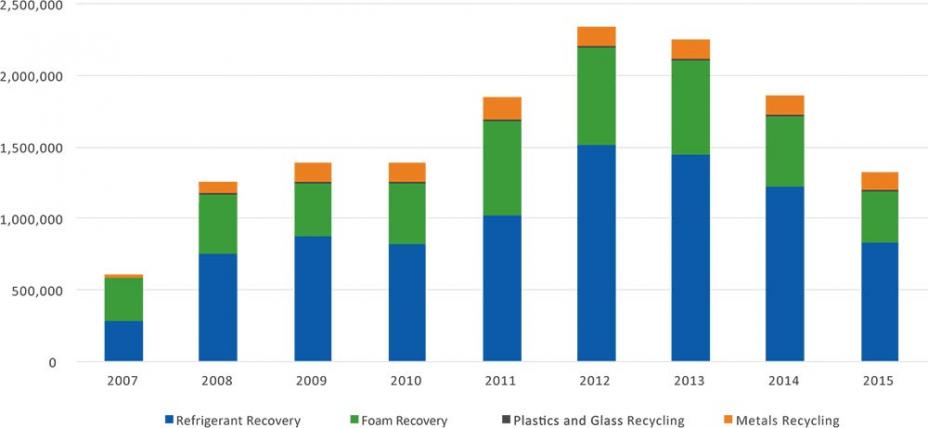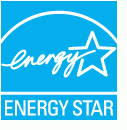Program Benefits
 What are the benefits of proper appliance disposal?
What are the benefits of proper appliance disposal?- What have RAD partners accomplished so far?
- Related Pages
What are the Benefits of Proper Appliance Disposal?
RAD Benefits from Properly Disposing of 1,000 Old Refrigerators (20+ years old)a
| Benefits | Cost Savings | Greenhouse Gas (GHG) Emissions Avoided MTCO2eq.)b | Ozone Depleting Substance (ODS) Emissions Avoided (ODP-weighted kg) | Other |
|---|---|---|---|---|
| Energy savings from preventing appliance resale/ reusec | $766,700d | 4,230 | N/A | Reduces energy consumption |
| Recycling ferrous and non-ferrous metalse | $5,820f | 145 | N/A | Saves landfill space and energy by recycling rather than landfilling durable materials |
| Recycling plastics, glass in lieu of landfilling | $2,680f | 14 | N/A | Saves landfill space and energy by recycling rather than landfilling durable materials |
| Avoided release of used oil | Not estimated | Not estimated | N/A | Avoided damage to the liver, brain, immune system, and reproductive system |
| Avoided release of mercury | Not estimated | Not estimated | N/A | Avoided impairment of neurological development and other problems associated with the human nervous system |
| Avoided release of polychlorinated biphenyls (PCBs) | Not estimated | Not estimated | N/A | Avoided carcinogenic and non-cancerous health effects |
| Avoided refrigerant emissions | $27,140g | 2,240 | 210 | Avoided cases of skin cancer, cataracts, skin problems, and immune system suppression |
| Avoided foam emissions | $25,050g | 2,070 | 440 | Avoided cases of skin cancer, cataracts, skin problems, and immune system suppression |
| TOTAL: | $827,390 | 8,698 | 650 |
a Values are based on average quantities of materials recovered per unit, based on 2013 RAD partner reports. Units are assumed to contain CFC-12 refrigerant and CFC-11 foam blowing agent.
b Metric tons of carbon dioxide equivalent (MTCO2eq.) calculated based on 100-year GWPs provided in the Intergovernmental Panel on Climate Change Fourth Assessment Report: Climate Change 2007.
c Assumes that a 21-year old unit has 6.89 remaining years of useful life based on the Department of Energy’s Technical Support Document for the 2009 Final Rule on Residential Refrigerators, Refrigerator-Freezers and Freezers, available at: www1.eere.energy.gov/buildings/appliance_standards/pdfs/refrig_finalrule_tsd.pdf. Assumes each refrigerator consumes an average of 890 kWh/year based on RAD partner reporting.
d Assumes an average 2014 U.S. electricity price of $0.125/kWh based on the U.S. Energy Information Administration’s (EIA’s) Electric Power Monthly electricity statistics, available at: http://www.eia.gov/electricity/monthly/epm_table_grapher.cfm?t=epmt_5_03.
e Ferrous and non-ferrous metals are typically recycled in the United States due to their high economic value, though such practices are ensured by RAD partners as part of their commitment to using best environmental practices.
f Calculated based on the U.S. annual average market value of payments received from scrap yard, as provided in ScrapIndex.com’s 2013 Annual Historical Market Price Information (available at www.scrapindex.com Exit). Actual values of scrap yard payments may fluctuate significantly within and across years.
g Calculated using the California auction reserve price on February 25, 2015, which was $12.10 per ton CO2eq. For more information, visit https://www.wci-auction.org/.Exit
What have RAD partners accomplished so far?
From 2007-2015, RAD partners achieved GHG reductions of over 14.2 million MTCO2eq., which is equivalent to the annual emissions of 3 million passenger cars.

From 2007 through 2015, RAD partners achieved emission reductions of over 14.2 MMTCO2eq.— equivalent to the annual emissions of 3 million passenger cars. Of this total, 61% can be attributed to recovering refrigerants, 31% to recovering foam-blowing agents, and 8% to recycling durable materials.
RAD partners have also prevented 837 million lbs. of ferrous metals (e.g., steel), 75 million lbs. of non-ferrous metals (e.g., copper), 143 million lbs. of plastic, and 22 million lbs. of glass from going to landfills. Additionally, RAD partners have ensured the proper handling of toxic or hazardous materials, including 628,000 gallons of used oil, 254,000 PCB-containing capacitors, and 141,000 mercury-containing components.
GHG Emissions Avoided through Proper Appliance Disposal by RAD Partners, 2007-2015 (MTCO2eq.)

Note: Ferrous and non-ferrous metals are typically recycled in the United States due to the high economic value of metals, though such practices are ensured by RAD partners as part of their commitment to using best environmental practices.
 In addition, RAD’s utility partners are committed to ensuring that old appliances being disposed of by one household do not get reused by other households, where they would continue wasting electricity due to their inefficiency. RAD partner utilities do this by offering cash for old appliances and/or rebates on the purchase of new ENERGY STAR units, as part of demand-side management programs aimed at reducing electricity use through energy efficiency and conservation.
In addition, RAD’s utility partners are committed to ensuring that old appliances being disposed of by one household do not get reused by other households, where they would continue wasting electricity due to their inefficiency. RAD partner utilities do this by offering cash for old appliances and/or rebates on the purchase of new ENERGY STAR units, as part of demand-side management programs aimed at reducing electricity use through energy efficiency and conservation.
In recent years, many of these utilities have joined forces with other RAD retailer partners that allow them to broaden their reach into consumer appliance channels. Together, these partners have made impressive strides in collecting a growing number of units and saving an increasing amount of energy. Since RAD’s inception, partners have reduced energy use by more than 22 billion kWh by permanently removing old refrigerators, stand-alone freezers, window air conditioning units, and dehumidifiers from the grid. This has collectively resulted in more than $2.8 billion in consumer savings.
For more detailed information on the benefits achieved by RAD partners, visit the Program Results page.
